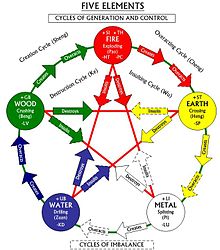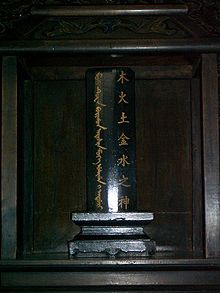- Wu Xing
-
For other uses, see Wu Xing (disambiguation).
Wu Xing Chinese 五行 Transcriptions Mandarin - Hanyu Pinyin wǔxíng - Wade–Giles wu3 hsing2 Min - Hokkien POJ Ngó͘-hân
Ngó͘-hîngCantonese (Yue) - Yale Romanization ng5 hang4
Part of a series on
TaoismFundamentals Dao (Tao) · De
Wuji · Taiji
Yin-Yang · Wu xing
Qi · Neidan
Wu weiTexts Deities Three Pure Ones
Guan Shengdi
Eight Immortals
Yellow Emperor · Xiwangmu
Jade Emperor · Chang'e
Other deitiesPeople Laozi · Zhuangzi
Zhang Daoling · Zhang Jue
Ge Hong · Chen Tuan
Wang ChongyangSchools Five Pecks of Rice
Celestial Masters
Shangqing · Lingbao
Quanzhen · Zhengyi
XuanxueSacred sites
The Wu Xing, also known as the Five Phases, the Five Agents, the Five Movements, and the Five Steps/Stages, are chiefly an ancient mnemonic device, in many traditional Chinese fields.
It is sometimes translated as Five Elements, but the Wu Xing are chiefly an ancient mnemonic device, hence the preferred translation of "movements", "phases" or "steps" over "elements". By the same token, Mu is thought of as "Tree" rather than "Wood".[1]
The five elements are:
- Wood (Chinese: 木, pinyin: mù)
- Fire (Chinese: 火, pinyin: huǒ)
- Earth (Chinese: 土, pinyin: tǔ)
- Metal (Chinese: 金, pinyin: jīn)
- Water (Chinese: 水, pinyin: shuǐ)
The system of five phases was used for describing interactions and relationships between phenomena. It was employed as a device in many fields of early Chinese thought, including seemingly disparate fields such as geomancy or Feng shui, astrology, traditional Chinese medicine, music, military strategy and martial arts.
The system is still used as a reference in some forms of complementary and alternative medicine and martial arts. Some[who?] claim the original foundation of these are the concept of the Five Cardinal Points.
Contents
Cycles
The doctrine of five phases describes two cycles, a generating or creation (生, shēng) cycle, also known as "mother-son", and an overcoming or destruction (剋/克, kè) cycle, also known as "grandfather-nephew", of interactions between the phases.
Generating
The common memory jogs, which help to remind in what order the phases are:
- Wood feeds Fire;
- Fire creates Earth (ash);
- Earth bears Metal;
- Metal carries Water (as in a bucket or tap, or water condenses on metal);
- Water nourishes Wood.
Other common words for this cycle include "begets", "engenders" and "mothers."
Overcoming
- Wood parts Earth (such as roots; or, Trees can prevent soil erosion);
- Earth absorbs (or muddies) Water (or an Earth dam can control water);
- Water quenches Fire;
- Fire melts Metal;
- Metal chops Wood.
This cycle might also be called "controls", "restrains" or "fathers".
Cosmology and feng shui
Main article: Feng shuiAccording to Wu Xing theory, the structure of the cosmos mirrors the five phases. Each phase has a complex series of associations with different aspects of nature, as can be seen in the following table. In the ancient Chinese form of geomancy known as Feng Shui practitioners all based their art and system on the five phases (Wu Xing). All of these phases are represented within the Ba gua. Associated with these phases are colors, seasons and shapes; all of which are interacting with each other.[2]
Based on a particular directional energy flow from one phase to the next, the interaction can be expansive, destructive, or exhaustive. With proper knowledge of such aspect of energy flow will enable the Feng Shui practitioner to apply certain cures or rearrangement of energy in a way they believe to be beneficial for the receiver of the Feng Shui "Treatment".
Ba gua
Main article: Ba guaThe movements have also been correlated to the eight trigrams of the I Ching:
Movement Metal Earth Wood Wood Water Fire Earth Metal I Ching Heaven Earth Thunder Wind Water Fire Mountain Lake Trigrams ☰ 乾 qián ☷ 坤 kūn ☳ 震 zhèn ☴ 巽 xùn ☵ 坎 kǎn ☲ 離 lí ☶ 艮 gèn ☱ 兌 duì Chinese medicine
Main article: Traditional Chinese medicineThe interdependence of Zang Fu networks in the body was noted to be a circle of five things, and so mapped by the Chinese doctors onto the five phases. For instance, the Liver (Wood phase) is said to be the "mother" of the heart (Fire phase), and the Kidneys (Water phase) the mother of the Liver. The key observation was things like kidney deficiency affecting the function of the liver. In this case, the "mother" is weak, and cannot support the child. However, the Kidneys control the heart along the Ke cycle, so the Kidneys are said to restrain the heart. Many of these interactions can nowadays be linked to Western physiological pathways (such as Kidney pH affecting heart activity).[clarification needed]
The key thing to keep in mind with the Chinese medical application of the five elements is that it is only a model, and it is known to have exceptions.
The citation order of the Five Phases, i.e., the order in which they are cited in the Bo hu tong 白虎通 and other Han dynasty texts, is Metal, Wood, Water, Fire, and Earth. The organs are most effectively treated, according to theory, in the following four-hour periods throughout the day, beginning with the 3 a.m. to 7 a. m. period: Metal organs (see the list below), Earth organs, Fire1 organs, Water organs, Fire2 (the "non-empirical" Pericardium and Triple Burner organs), and Wood organs, which is the reverse of the citation order (plus an extra use of Fire and the non-empirical organs to take care of the sixth four-hour period of the day). These two orders are further related to the sequence of the planets going outward from the sun (Mercury, Venus, Mars, Jupiter, Saturn, or Water, Metal, Fire, Wood, and Earth) by a star diagram similar to the one shown above.[3]
The sequence of the five elements (Traditional Chinese medicine):promotion, inhibition, Cheng (bullying), Wu (insult).
Movement Wood Fire Earth Metal Water Planet Jupiter Mars Saturn Venus Mercury Mental Quality Sensitivity Creativity Clarity[disambiguation needed  ]
]Intuition Spontaneity[disambiguation needed  ]
]Emotion anger happiness love grief, sadness fear, scare Zang (yin organs) liver heart/pericardium spleen/pancreas lung kidney Fu (yang organs) gall bladder small intestine/San Jiao stomach large intestine urinary bladder Sensory organ eyes tongue Mouth nose ears Body Part Tendons Pulse Muscle Skin Bones Body Fluid Tears Sweat Saliva Mucus Urine Finger index finger middle finger thumb ring finger little finger Sense sight speech taste smell hearing Taste[5] sour bitter sweet pungent salt sour sweet pungent bitter Smell Rancid Scorched[disambiguation needed  ]
]Fragrant Rotten Putrid Life Youth Adult Hood Old Age Death Birth Animal scaly feathered shelled furred human Quinaries, fractal
Wu xing is self-similar fractal sets for unit, quinaries.[6][7][8][9][10][11], Wu xing's fractal dimension is Df=1.4650.
Celestial stem
Main article: Celestial stemMovement Wood Fire Earth Metal Water Heavenly Stem Jia 甲
Yi 乙Bing 丙
Ding 丁Wu 戊
Ji 己Geng 庚
Xin 辛Ren 壬
Gui 癸Year ends with 2, 7 3, 8 4, 9 0, 5 1, 6 Music
Main article: Chinese musicThe Yuèlìng chapter (月令篇) of the Lǐjì (禮記) and the Huáinánzǐ (淮南子) make the following correlations:
Movement Wood Fire Earth Metal Water Colour Green and Blue Red Yellow White Black Direction east south center west north The Basic Pentatonic Scale jué 角 (mi) zhǐ 徵 (so) gōng 宮 (do) shāng 商 (re) yǔ 羽 (la) (Notes:
- The Chinese word 青 qīng, has many meanings, including green, azure, cyan, and black. It refers to green in Wu Xing.
- In most modern music, various seven note or five note scales (e.g., the major scale) are defined by selecting seven or five frequencies from the set of twelve semi-tones in the Equal tempered tuning. The Chinese "lǜ" tuning is closest to the ancient Greek tuning of Pythagoras. See Chinese musicology.)
Martial arts
Taijiquan
Main article: T'ai chi ch'uanTaijiquan uses the five elements to designate different directions, positions or footwork patterns. Either forward, backward, left, right and centre, or three steps forward (attack) and two steps back (retreat).[12]
The Five Steps (五步 wǔ bù):
- Chin Pu (進步 jìn bù) - Forward step.
- T'ui Pu (退步 tùi bù) - Backward step.
- Tsuo Ku (左顧 (simpl.: 左顾) zǔo gù) - Left step.
- You P'an (右盼 yòu pàn) - Right step.
- Chung Ting (中定 zhōng dìng) - The central position, balance, equilibrium.
Xingyiquan
Main article: XingyiquanXingyiquan uses the five elements to metaphorically represent five different states of combat.
Movement Fist Chinese Pinyin Description Metal Splitting 劈 Pī To split like an axe chopping up and over. Water Drilling 鑽 Zuān Drilling forward horizontally like a geyser. Wood Crushing 崩 Bēng To collapse, as a building collapsing in on itself. Fire Pounding 炮 Pào Exploding outward like a cannon while blocking. Earth Crossing 橫 Héng Crossing across the line of attack while turning over. Tea ceremony
There are spring, summer, fall, and winter teas. The perennial tea ceremony ("perennial", literally means four steps or sequences that are linked together, each representing a season of the year) includes four tea settings(茶席) and a tea master(司茶). The tea settings are:
- earth, center incense, yellow, up and down
- wood, 春風(Spring Wind), green, east
- fire, 夏露(Summer Dew), red, south
- metal, 秋籟(Fall Sounds), white, west
- water, 冬陽(Winter Sunshine) black, north
Each tea setting is arranged and stands for the four directions (north, south, east, and west). A vase of the seasons' flowers is put on tea table. Sometimes if four tea masters are included then five chairs are arranged per tea setting, making a total of twenty plus the 4 tea masters equalling 24, which symbolizes the 24 solar terms of the Chinese calendar, and represents that nature continues or is perennial.
See also
- Color in Chinese culture
- Flying Star Feng Shui
- Humorism
- Qi
- Zang Fu
- Wu Xing Painting
Bibliography
- Feng Youlan (Yu-lan Fung), A History of Chinese Philosophy, volume 2, p. 13
- Joseph Needham, Science and Civilization in China, volume 2, pp. 262–23
- Maciocia, G. 2005, The Foundations of Chinese Medicine, 2nd edn, Elsevier Ltd., London
References
- ^ 千古中医之张仲景. Wood and Metal were often replaced with air. Lecture Room, CCTV-10.
- ^ Chinese Five Elements Chart Information on the Chinese Five Elements from Northern Shaolin Academy in Microsoft Excel 2003 Format
- ^ See 5 Xing in Citation Order.
- ^ promotion inhibition Cheng wu
- ^ Eberhard, Wolfram (December 1965). "Chinese Regional Stereotypes". Asian Survey (University of California Press) 5 (12): 596–608. JSTOR 2642652.
- ^ Deng Yu, Zhu Shuanli, Xu Peng et al邓宇,朱栓立,徐彭,New Translator with Characteristic of Wu xing Yin Yang五行阴阳的特征与新英译,Chinese Journal of Integrative Medicine中国中西医结合杂志,2000, 20 (12)
- ^ Deng Yu邓宇,等; Fresh Translator of Zang Xiang Fractal five System藏象分形五系统的新英译,Chinese Journal of Integrative Medicine中国中西医结合杂志; 1999
- ^ Deng Yu邓宇等,Nature with Math Physics Yin Yang数理阴阳与实质, Journal of Mathematical Medicine数理医药学杂志, 1999年。
- ^ Deng Yu et al邓宇等, 阴阳的科学本质及数理化建构,Chinese Journal of basic medicine in traditional chinese medicine <<中国中医基础医学杂志>>1998,2:59-61.
- ^ Deng Yu邓宇等,TCM Fractal Sets中医分形集,Journal of Mathematical Medicine<<数理医药学杂志>> ,1999,12(3),264-265
- ^ Deng Yu, Zhu Shuanli, Xu Peng et al邓宇,朱栓立,徐彭等,Essence and New Translator of Channels经络英文新释译与实质,Chinese Journal of Integrative Medicine中国中西医结合杂志,2000,20(8):615
- ^ Wu, Kung-tsao (1980, 2006). Wu Family T'ai Chi Ch'uan (吳家太極拳). Chien-ch’uan T’ai-chi Ch’uan Association. ISBN 0-9780499-0-X.
External links
- Five Elements Malaysia I Ching Net
- Five Element Information Five Element interrelationships, concordances and causative factors.
Categories:- Wu Xing
- Chinese philosophy
- Chinese thought
- Natural philosophy
- Traditional Chinese medicine
- Cultural lists
Wikimedia Foundation. 2010.





